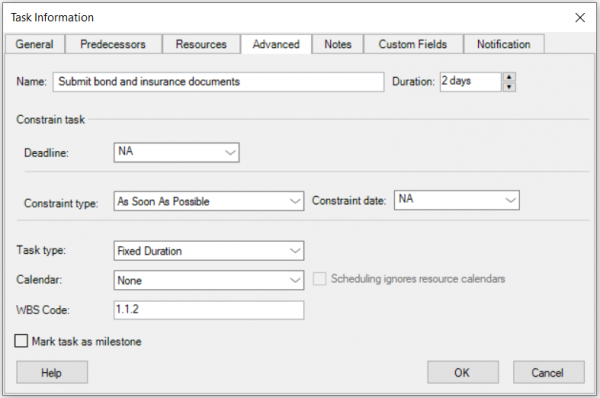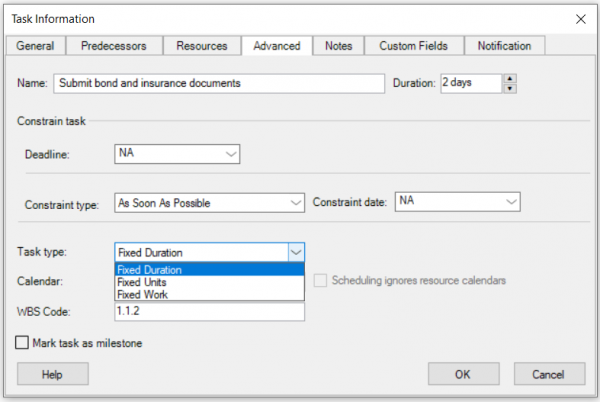Set Task Type
Online Help > Set Task Type
What does the “Set Task Type” functionality do?
The “Set Task Type” functionality, as the name indicates, allows you to change the types of automatically-scheduled tasks. The available task types are: fixed units, fixed work, and fixed duration. Project looks at a task's type to determine how duration, work, and units will behave as Project schedules your project.
How many task types are there?
There are three available task types: Fixed Units, Fixed Duration and Fixed Work.
What is Type field?
The Type field provides choices that control the effect that editing work, assignment units, or duration has on the calculations of the other two fields.
What is Fixed Units Task Type?
Fixed Units Task Type applies to a task in which the assigned units (or resources) is a fixed value and any changes to the amount of work or the task's duration do not affect the task's units.
What is Fixed Work Task Type?
Fixed Work Task Type applies to a task in which the amount of work is a fixed value and any changes to the task's duration or the number of assigned units (or resources) do not affect the task's work.
What is Fixed Duration Task Type?
Fixed Duration Task Type applies to a task in which the duration is a fixed value and any changes to the work or the assigned units (that is, resources) don't affect the task's duration.
Why can’t the summary task type be changed?
Summary tasks are always fixed-duration types because a summary task's start and finish dates are determined by its subtasks.
Why am I not able to set the task type for a task?
If the task type box is grayed out it means the task you have selected is a manual tasks. Task types apply only to automatically-scheduled tasks.
What role do task types have?
Task types help to determine how duration, work and units will behave as Project Plan 365 schedules your project.
What happens when editing the units of a fixed units task?
If you edit the units of a fixed units tasks, the duration will be recalculated.
What happens when editing the units of a fixed work task?
If you edit the units of a fixed work task, the duration will be recalculated.
What happens when editing the units of a fixed duration task?
If you edit the units of a fixed duration task, work will be recalculated.
What happens if I edit the duration of a fixed units task?
If you edit the duration of a fixed units task, work will be recalculated.
What happens if I edit the duration of a fixed work task?
If you edit the duration of a fixed work task, nothing happens. Changing scalar work after making an assignment on a task will no longer automatically alter the Assignment Units field.
What happens if I edit the duration of a fixed duration task?
If you edit the duration of a fixed duration task, work will be recalculated.
What happens if I edit the work amount of a fixed units task?
If you modify the work amount of a fixed units task, the duration will be recalculated.
What happens if I edit the work amount of a fixed work task?
If you modify the work amount of a fixed work task, the duration will be recalculated.
What happens if I edit the work amount of a fixed duration task?
If you modify the work amount of a fixed duration task, the units will be recalculated.
What is the difference between task types and task constraints?
If you want to impose restrictions on the way the application calculates the start and finish dates, task constraints do the job rather than task types.
What is the difference between Fixed Units and Fixed Duration?
The difference between fixed units and fixed duration can be seen when modifying the units and work for a task. For Fixed units tasks, when revising units and work -duration is recalculated. For fixed duration tasks, when revising units - work is recalculated and when revising work-units are recalculated.
Can task types be used to change the hierarchical structure of a task?
In order to change the hierarchical structure of a task or subtask as part of an outline structure for your project, you need to indent or outdent the task rather than change the task type or add a deadline date.
How do task types affect the project?
Each of the task types affects scheduling when you edit one of the three elements as follows:
In a | If you revise units | If you revise duration | If you revise work |
Fixed units task | Duration is recalculated. | Work is recalculated. | Duration is recalculated. |
Fixed work task | Duration is recalculated. | - | Duration is recalculated. |
Fixed duration task | Work is recalculated. | Work is recalculated. | Units are recalculated. |
How to change a task type?
To change a task type, double click on the task name in the Gantt Chart, then in the Task Information dialog, go to Advanced tab and in the Task Type group select Fixed Units, Fixed Work or Fixed Duration and then click OK.
After I applied time-off for a resource, the start and finish dates for tasks didn’t change.
In order to recalculate the changes made on the resource calendar, set the Task Type to Fixed Units.
What is Task type?
Task types help the application determine how duration, work, and units will behave as Project Plan 365 schedules the project. The available task types are Fixed units, Fixed duration and Fixed work.
How do I list the task types in a schedule?
In order to see the task types, you need to insert the "Type" column. In order to do that, go to the Format menu, select the "Insert Column" option, from "Field Name" select "Type" and press "OK".
Step by step on how to change a task type:
1. Double click on the task name in the Gantt Chart.
2. In the Task Information dialog, go to the Advanced tab.
3. In the Task Type group select Fixed Units, Fixed Work or Fixed Duration.
4. Click OK.
Some examples:
1. Let's say you have a fixed-units task, with 1 full-time resource unit available for 8 hours each day. You set the task up with a 10-day duration and 80 hours of work.
If you find out that another full-time resource can assist on the task, Project recalculates the task's duration. The task now has two units assigned, with a 5-day duration and 80 hours of work.
If you find out that you have 8 days to complete the task rather than 10, Project recalculates the task's work. The task now has an 8-day duration, with 64 hours of work and 1 resource unit.
If you find out that the task will take 20 hours of additional work, Project recalculates the task's duration. The task now has 100 hours of work, with a duration of 12.5 days and 1 resource unit.
2. Now let's say you make the same task a fixed-work task. This means that the task can take only the amount of work that you specify: no more, no less. In this example, the task has 1 full-time resource available for 8 hours each day, and it has a 10-day duration with 80 hours of work.
If you find out that another full-time resource can assist on the task, Project recalculates the task's duration. The task now has 2 units assigned, with a 5-day duration and 80 hours of work.
If you find out that the task will take 20 hours of additional work, Project recalculates the task's duration. The task now has 100 hours of work, with a duration of 12.5 days and 1 resource unit.
3. Finally, let's say you make the same task a fixed-duration task. This means that the task must be completed in the duration that you specify. Again, in this example, the task has 1 full-time resource available for 8 hours each day, and it has a 10-day duration with 80 hours of work.
If you find out that another resource can assist on the task, Project recalculates the work assigned to each resource. When just 1 resource was assigned to the task, that resource had 80 hours of work to complete. When you assign another resource to the task, each resource has 40 hours of work to complete over the same 10-day duration, for a total of 80 hours of work. By adding another resource unit, you also revise the allocation of both units to 50% each, making them both available to work 50% on other tasks.
If you find out that you have 8 days to complete the task rather than 10, Project recalculates the task's work. The task now has an 8-day duration, with 64 hours of work and 1 resource unit.
If you find out that the task will take 20 hours of additional work, Project recalculates the task's resource units, so that the additional work can still be completed within the 10-day duration. The task now has 100 hours of work, with a duration of 10 days and 1.25 resource units. The resource unit that is currently assigned to the task is allocated at 125%. You need to assign another resource to account for the additional 25% allocation.
Tips and Gotchas | Explanation |
Summary tasks are always fixed-duration tasks | Summary tasks are always fixed-duration types because a summary task's start and finish dates are determined by its subtasks. |
Use indenting to outline, not task types | If you want to change the hierarchical structure of a task or subtask as part of an outline structure for your project, you need to indent or outdent the task rather than change the task type or add a deadline date. |
Don't' confuse task constraints, like ASAP, with task types | If you want to impose restrictions on the way Project calculates the start and finish dates of tasks, you need to set a task constraint, rather than the task type. |
| Related | Task Information | Link Unlink Tasks | Insert Task | Set Milestones | Set Task Mode |
| Platform | Windows | Mac | iOS | Web | Android |
| ✔ | ✔ | ✔ | ✔ | ✔ | |
| Product | Project Plan 365 | ||||
| Date | 02/01/2021 |



